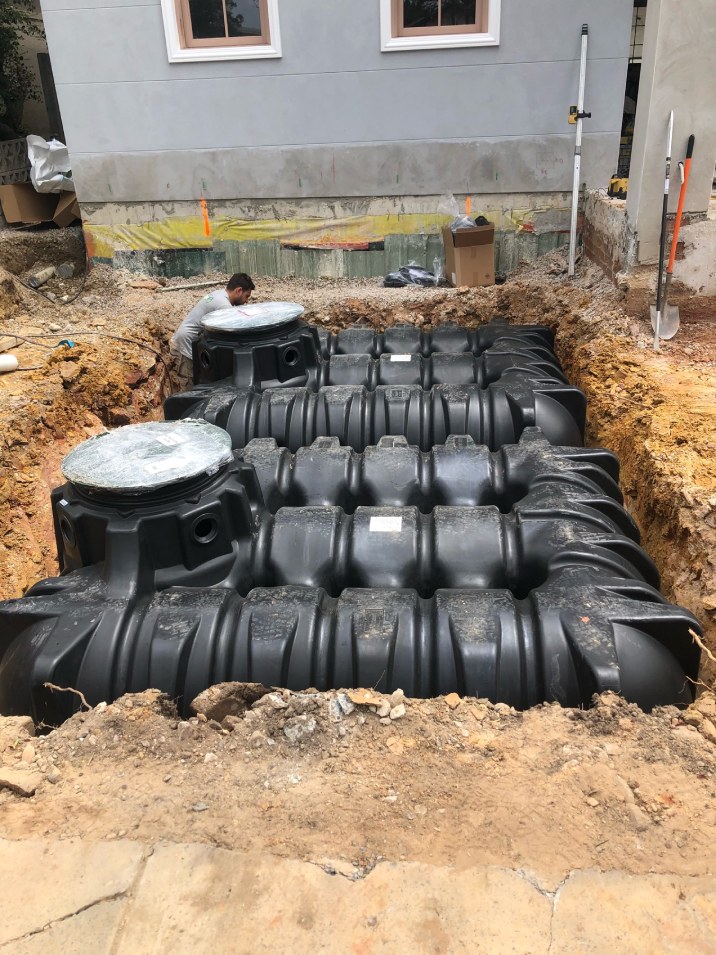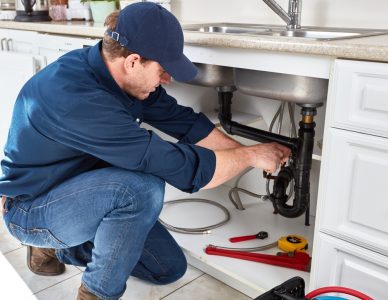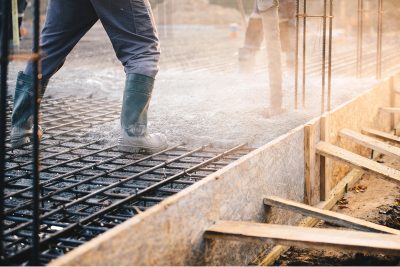- Oneflare /
- Cost Guides /
- Septic Tank

How Much Does a Septic Tank Cost?
$7,000 - $20,000
Oneflare
Updated June 10, 2025 |
6 minute read
How much does a septic tank cost?
Septic tanks are an important part of a septic system. All your home’s outward drains and pipes lead to a septic tank. It’s where bacteria treat wastewater from your house. Once the water is treated, a disposal system disperses the water within your property. If you need to repair, replace or build a septic tank, you’ll want to know how much a septic tank costs.
Installing a septic tank can cost anywhere from $7,000 to $20,000, depending on various factors such as the type of septic system, your location, and the tank material. In this article, we’ll go through the factors behind septic tank costs in Australia and their estimated price ranges.
Septic tank installation prices in Australia based on location
| City | Average installation cost |
| Sydney | $10,000–$20,000 |
| Melbourne | $10,000–$20,000 |
| Brisbane | $7,000–$15,000 |
| Adelaide | $15,000–$20,000 |
Septic tank cleaning prices
How much does it cost to clean a septic tank?
The average cost is between $250 and $600. Most homeowners spend approximately $375. The cost of pumping out the tank could be about $250 for a 3,000-litre tank and up to $1,000 for a 5,000-litre tank.
Price estimates for different septic tank types and materials
Average cost based on septic tank types
| Septic tank type | Average cost |
| Conventional septic tank | $2,000 – $12,000 |
| Aerobic/Aerated Wastewater Treatment Systems (AWTS) | $10,000 – $20,000 |
| Septic tank with sand filter | $5,000 – $20,000 |
Average cost based on septic tank materials
| Material | Average cost |
| Concrete | $1,200 to $5,000 is the concrete septic tank price for a tank that ranges in size from 3,000 litres – 12,000 litres |
| Steel | $3,000 to $10,000 is the average cost. Most homeowners spend between $3,500 to $5,000 |
| Plastic | $500 to $1,500 for a tank that ranges in size from 3,000 to 5,000 litres |
| Fibreglass | $1,500 to $2,000 for the average home with three to four bedrooms |
| Poly | Poly septic tank prices range from $500 to $1,500 for an average size tank between 3,000 – 5,000 litres. |

Septic tank construction. | Source: GURNETT GROUP PTY LTD
Factors impacting the cost of a septic tank installation
Do you still need more details on how much a septic tank costs? Many variables can affect this. These factors will determine the materials and labour cost of your septic tank installation project.
Location or site
Your property’s location will impact costs because of the type of septic system you’ll need and the terrain in the area. For example, above-ground systems are better for rocky terrains, while underground septic systems take more prep work but are less exposed to the elements.
Between the two, above-ground septic systems are typically less expensive to set up, but underground systems are more cost-effective to maintain.
Septic tank cost and installation, just like building costs, will include labour fees and permit/inspection costs, dependent on your locale.
The job you want done
Putting up a new septic tank system won’t be the same as the cost to replace a septic tank. As with other home renovation and repair concerns, this can depend on what you want for your replacement tank and other considerations.
Type of septic system and treatments
The cost of a septic tank system can also vary based on the system you choose. Here are the typical kinds of septic systems that you can choose from:
Sand filter septic system
Here, the wastewater passes through a sand filter before being distributed to the surrounding area. Meanwhile, the sand filter captures solid waste and encourages friendly bacteria to digest the waste. The sand filter is underground and usually has turf growing on top.
Evapotranspiration beds
This septic system works best if you life in a rather dry, arid area. Wastewater leaves the septic tank and goes through perforated pipes into a gravel bed before evaporating into the turf above.
Advanced secondary treatment systems (STS) and Aerated wastewater treatment systems (AWTS)
Here, the wastewater passes from the septic tank to a holding tank so that solid waste can settle and bacteria can process it anaerobically (without oxygen). The waste or effluent then goes through an aeration tank, where it is treated with oxygen so that aerobic bacteria can process it.
The waste is then treated with chlorine and UV light as the final step in the treatment process. Because of its complexity, this system is often priced higher than the other two.
Size of the tank
Prices of septic tanks will depend on their size. In Australia, it is recommended that those with two- to three-bedroom houses get a 2,400L capacity tank, while those with bigger homes have tanks with a 4,500L capacity or more. This accounts for the wastewater from every occupant’s use, such as cooking, using the bathroom, washing clothes and dishes, and cleaning the home.
Tank material
There are two types of septic tank material: concrete and plastic. Concrete septic tanks are more durable and reliable. They’re less likely to leak, freeze, or crack even with the harsh Australian weather, making them quite low-maintenance. However, concrete septic tanks are priced higher than their plastic counterparts.
The other type, plastic septic tanks, are a budget-friendly option suitable for first-time homeowners and can cost around half the price of concrete. But, they may not last as long as concrete septic tanks.
Labour costs
Septic tank system cost isn’t the only factor to consider—you’ll also need to account for the labour involved in installing or replacing the parts. Costs will depend on the plumber or installer you’re working with and the scope of the job.
How do you know when you need to install a new septic system?
While you should maintain your septic system by regular inspection and pumping (ideally with the help of a plumber), here are some signs that it’s time to replace the tank:
- A foul smell in the air around the septic system. If you or your neighbours notice a rotten eggs-like odour, it’s time to get your tank checked.
- Damp or soggy ground, or pools in the area nearby. This could be a sign of a malfunctioning system.
- Slow-draining or backed-up toilets. A septic system that can’t take in any more input, even after pumping or cleaning, may need replacement.
- Bright green grass in the draining area, even in warm weather. This could indicate untreated sewage coming to the surface and affecting the environment.
- It’s been years since you had the system put in. Like most items in your property, your septic tank will experience wear and tear and require repair or even replacement.
Not only does your home or furniture need regular maintenance or renovation—your septic system also needs a check-up.
5 Tips when hiring a septic tank installer
Even though you don’t see it all the time, you depend on your septic tank to work properly every single day. Just like when you hire a builder for your house, it’s important to choose a septic tank installer who is knowledgeable and qualified. Here are some tips to help you get started:
- Ask for quotes from multiple service providers before committing to one.
- Ask for proof of their qualifications and licencing.
- Ask about other jobs they’ve done in your area. This is important because of health and environmental regulations specific to your state, city, or town.
- Ask about the pros/cons of septic tank materials or sewer systems.
- Ask about the maintenance processes for the sewer system and tank you have in mind.
Tackle your septic tank woes with the right contractor
With good planning, a solid idea of your budget and your home’s needs, deciding on the right septic system installer can be easy.
Now that you know what to look for when reviewing the cost of a septic system and hiring an installer, it’s time for you to start canvassing and requesting quotes! Remember to stick to qualified and certified plumbers specialising in septic tank installation so you get your money’s worth and peace of mind.
* The cost data is based on Oneflare and third-party sources
FAQs on septic tank installation cost
What is the cheapest septic system to put in?
Opt for a conventional system such as the sand filter or evapotranspiration beds to make your septic installation more affordable. Choosing a plastic septic tank can also help cut costs.
How far can a septic tank be from a house in Australia?
According to government regulations, a septic tank should be located at minimum clearance distances from water sources, buildings and boundaries to avoid damage and external threats.
- 15 metres away from houses and play areas
- 12 metres uphill or 6 metres downhill from other properties
- 100 metres away from streams
- 50 metres minimum from dams or wells used for water supply.
It’s best to check with your local government for more accurate recommendations.
What are the signs of septic tank problems?
Some signs of septic tank problems include foul smells near the draining field, backed-up drains and toilets, and bright green grass in the draining area, even during warm weather. It’s important to keep up with your septic tank maintenance schedule and stay informed on properly disposing of materials down your drains.


